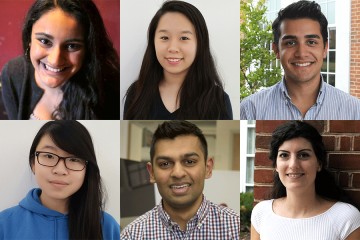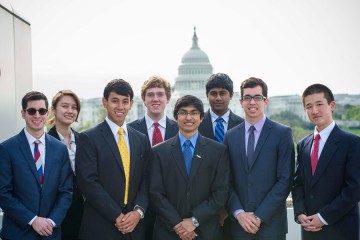A Johns Hopkins student team that wants to help people breathe easier has been selected as a finalist in the 2017 Collegiate Inventors Competition, organizers of the event announced Tuesday. The students devised a simple, discreet device to open obstructed nostrils, a common problem that can cause snoring and other sleep disruptions, as well as exercising difficulties.
The AssistENT team, formed by biomedical engineering majors during the 2016–17 academic year, is one of six undergraduate finalists that will compete for top honors and prizes worth up to $10,000 during the competition. The final judging is scheduled for Nov. 3 at the U.S. Patent and Trademark Office in Alexandria, Virginia.
"We're all pretty excited about this," team leader Clayton Andrews said. "This is an affirmation that what we're doing is something that people will appreciate. This device makes sense, and we hope it will eventually make a difference in people's lives."
The annual contest, a program of the National Inventors Hall of Fame, was introduced in 1990. Since then, with the help of sponsors, the event has awarded more than $1 million to innovative undergrads and graduate student teams. This marks the 14th time a Johns Hopkins student team has been a finalist, event organizers said.
The need for a better way to open restricted nasal passages was brought to the AssistENT team's attention last year by Patrick J. Byrne, a Johns Hopkins professor of otolaryngology/head and neck surgery and director of the Division of Facial Plastic and Reconstructive Surgery.
The students learned that one out of every eight people have trouble breathing through their nose due to an obstruction in their nostrils. Some people opt for reconstructive surgery to open their nasal passages, but about a fifth of these patients say this only worsened the condition. Other people used over-the counter adhesive strips and other dilation products to open their airways. But the students say many users complain that these options are ineffective, uncomfortable, and too unsightly to wear in public.
Andrews and his team, who were enrolled in a biomedical design course, sought to devise a better tool to address the restricted breathing problem. Advised by Byrne and course instructor Robert H. Allen, the students designed and began testing a nasal dilator that could open obstructed nostrils while resting unseen within the nose. They also fabricated a tool to safely and easily insert and remove the dilator.
Andrews said he had a personal reason for pursuing this particular project.
"I have experienced nasal obstruction myself," he said. "I learned that not everyone wants to undergo surgery to fix it. There's no guarantee of success."
Andrews graduated in the spring, but he obtained a Johns Hopkins fellowship that has allowed him to remain in Baltimore and continue working on the AssistENT project. The "ENT" in the project's title is a reference to the abbreviation for ear, nose, and throat doctors. The team is continuing to refine its product and hopes to begin testing the device in nasal obstruction patients in the near future.
At the upcoming Collegiate Inventors Competition, team members Harrison Nguyen, Talia Kirschbaum, and Pooja Nair will join Andrews in presenting the AssistENT project.
The AssistENT project was developed in a course offered through JHU's Center for Bioengineering Innovation & Design within the Department of Biomedical Engineering. The department is shared by the university's Whiting School of Engineering and its School of Medicine.











